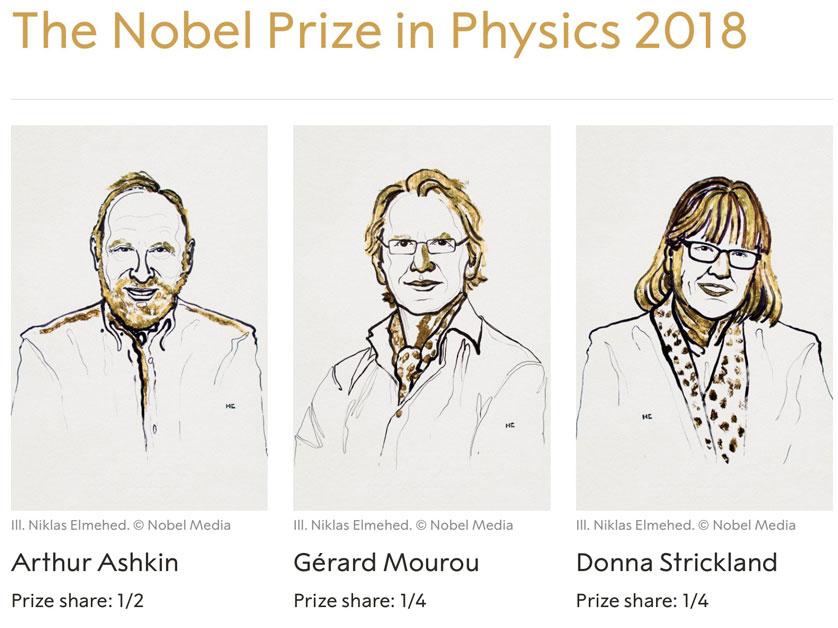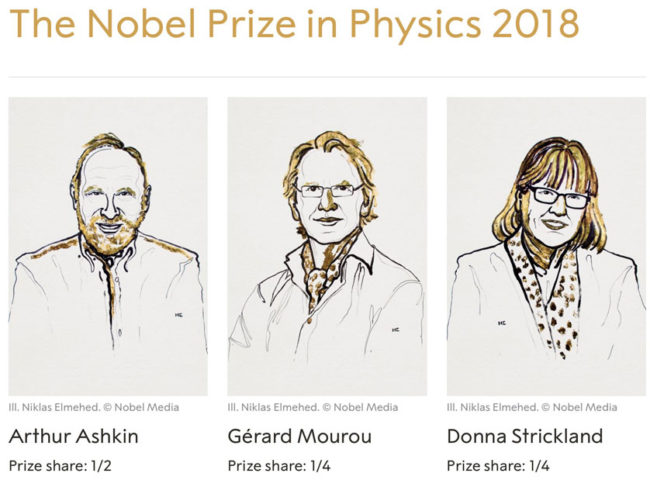This is about the 2nd of 4 prize announcements this week. Physics is perhaps the most popular of the Nobels. Many past physics winners are well-known names … Pierre and Marie Curie, Marconi, Planck, Einstein, Bohr, Hertz, Schrödinger, Fermi, Pauli, Bothe, Feynman and many more.
Marie Curie won because Pierre Curie refused to accept unless full credit was also shared with Marie. She later went on to win a second Nobel in Chemistry. She is the only human to ever have been awarded two Nobel Prizes. She is also one of only two women to have won the Physics prize.
That just changed.
Press Release: The Nobel Prize in Physics 2018
The Royal Swedish Academy of Sciences has decided to award the Nobel Prize in Physics 2018
“for groundbreaking inventions in the field of laser physics”
with one half to
Arthur Ashkin
Bell Laboratories, Holmdel, USA
“for the optical tweezers and their application to biological systems”
and the other half jointly to
Gérard Mourou
École Polytechnique, Palaiseau, France
University of Michigan, Ann Arbor, USA
and
Donna Strickland
University of Waterloo, Canada
“for their method of generating high-intensity, ultra-short optical pulses”
Tools made of light
The inventions being honoured this year have revolutionised laser physics. Extremely small objects and incredibly rapid processes are now being seen in a new light. Advanced precision instruments are opening up unexplored areas of research and a multitude of industrial and medical applications.
Arthur Ashkin invented optical tweezers that grab particles, atoms, viruses and other living cells with their laser beam fingers. This new tool allowed Ashkin to realise an old dream of science fiction – using the radiation pressure of light to move physical objects. He succeeded in getting laser light to push small particles towards the centre of the beam and to hold them there. Optical tweezers had been invented.
A major breakthrough came in 1987, when Ashkin used the tweezers to capture living bacteria without harming them. He immediately began studying biological systems and optical tweezers are now widely used to investigate the machinery of life.
Gérard Mourou and Donna Strickland paved the way towards the shortest and most intense laser pulses ever created by mankind. Their revolutionary article was published in 1985 and was the foundation of Strickland’s doctoral thesis.
Using an ingenious approach, they succeeded in creating ultrashort high-intensity laser pulses without destroying the amplifying material. First they stretched the laser pulses in time to reduce their peak power, then amplified them, and finally compressed them. If a pulse is compressed in time and becomes shorter, then more light is packed together in the same tiny space – the intensity of the pulse increases dramatically.
Strickland and Mourou’s newly invented technique, called chirped pulse amplification, CPA, soon became standard for subsequent high-intensity lasers. Its uses include the millions of corrective eye surgeries that are conducted every year using the sharpest of laser beams.
The innumerable areas of application have not yet been completely explored. However, even now these celebrated inventions allow us to rummage around in the microworld in the best spirit of Alfred Nobel – for the greatest benefit to humankind.
Read more about this year’s prize
Tweets
Physics Nobel goes to laser researchers — including just the third woman ever: https://t.co/jM9PMKmm6P pic.twitter.com/bra045mIz6
— Discover Magazine (@DiscoverMag) October 2, 2018
https://twitter.com/UWaterloo/status/1047138842120089600
Donna Strickland has joined Maria Goeppert-Mayer and Marie Curie to become the third woman to ever win a Nobel Prize in Physics https://t.co/qFcVipQ11d pic.twitter.com/E7ekJsz3lJ
— Gizmodo (@Gizmodo) October 2, 2018
IOP applauds @NobelPrize for laser physicists and hails third female laureate. Read more https://t.co/gQusjxIpKX Image © Nobel Media AB 2018 #Nobelprize pic.twitter.com/6FYl7qdY6E
— Institute of Physics (@PhysicsNews) October 2, 2018
https://twitter.com/sciam/status/1047121725371158529

